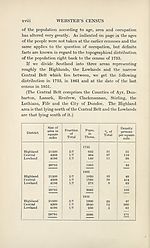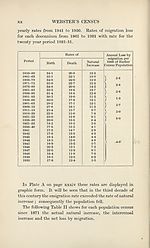Series 3 > Scottish population statistics, including Webster's Analysis of population, 1755
(26) Page xix
Download files
Complete book:
Individual page:
Thumbnail gallery: Grid view | List view

INTRODUCTION
XIX
It will be seen that in the middle of the eighteenth
century more than half of the population lived north of
the Central Belt, but by 1951 only one-fifth of the popula¬
tion were in this district, which constitutes more than
70 per cent, of the area of Scotland. More dramatic still,
however, is the fact that by 1951 three-quarters of the
population were concentrated with a density of 900 persons
to the square mile into the Central Belt, which comprises
but one-seventh of the area of Scotland. These figures
indicate the profound changes which have taken place
since the middle of the eighteenth century in the regional
distribution of our population.
The growth of population depends normally on the
excess of births over deaths—commonly called the “ natural
increase.” In modern times with the improved facilities
for travel and with the opening up of new fields of develop¬
ment throughout the world the growth in a population
may be greatly affected by migration.
The birth-rate has been falling since the last decade of
the nineteenth century, and although the death-rate began
to fall about the same time its fall has not been so rapid.
Consequently the rate of natural increase of the population
has had a downward trend for about sixty years.
The further decremental force of emigration has markedly
affected our population growth. The following table gives
quinquennial averages for birth, death and natural increase
rates to 1940. As the rates for years after 1940 were
violently affected by war conditions, they are given for
individual years. The migration rates are shown in
decennial averages up to 1931.
Table I
Quinquennial averages of rates of birth, death and
natural increase from 1855-60 to 1936-40 and individual
XIX
It will be seen that in the middle of the eighteenth
century more than half of the population lived north of
the Central Belt, but by 1951 only one-fifth of the popula¬
tion were in this district, which constitutes more than
70 per cent, of the area of Scotland. More dramatic still,
however, is the fact that by 1951 three-quarters of the
population were concentrated with a density of 900 persons
to the square mile into the Central Belt, which comprises
but one-seventh of the area of Scotland. These figures
indicate the profound changes which have taken place
since the middle of the eighteenth century in the regional
distribution of our population.
The growth of population depends normally on the
excess of births over deaths—commonly called the “ natural
increase.” In modern times with the improved facilities
for travel and with the opening up of new fields of develop¬
ment throughout the world the growth in a population
may be greatly affected by migration.
The birth-rate has been falling since the last decade of
the nineteenth century, and although the death-rate began
to fall about the same time its fall has not been so rapid.
Consequently the rate of natural increase of the population
has had a downward trend for about sixty years.
The further decremental force of emigration has markedly
affected our population growth. The following table gives
quinquennial averages for birth, death and natural increase
rates to 1940. As the rates for years after 1940 were
violently affected by war conditions, they are given for
individual years. The migration rates are shown in
decennial averages up to 1931.
Table I
Quinquennial averages of rates of birth, death and
natural increase from 1855-60 to 1936-40 and individual
Set display mode to:
![]() Universal Viewer |
Universal Viewer | ![]() Mirador |
Large image | Transcription
Mirador |
Large image | Transcription
Images and transcriptions on this page, including medium image downloads, may be used under the Creative Commons Attribution 4.0 International Licence unless otherwise stated. ![]()
| Scottish History Society volumes > Series 3 > Scottish population statistics, including Webster's Analysis of population, 1755 > (26) Page xix |
|---|
| Permanent URL | https://digital.nls.uk/126796203 |
|---|
| Attribution and copyright: |
|
|---|
| Description | Over 180 volumes, published by the Scottish History Society, containing original sources on Scotland's history and people. With a wide range of subjects, the books collectively cover all periods from the 12th to 20th centuries, and reflect changing trends in Scottish history. Sources are accompanied by scholarly interpretation, references and bibliographies. Volumes are usually published annually, and more digitised volumes will be added as they become available. |
|---|


